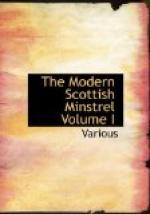Lady Anne Lindsay was the eldest of a family of eight sons and three daughters, born to James, Earl of Balcarres, by his spouse, Anne Dalrymple, a daughter of Sir Robert Dalrymple, of Castleton, Bart. She was born at Balcarres, in Fife, on the 8th of December 1750. Inheriting a large portion of the shrewdness long possessed by the old family of Lindsay, and a share of talent from her mother, who was a person of singular energy, though somewhat capricious in temper, Lady Anne evinced, at an early age, an uncommon amount of sagacity. Fortunate in having her talents well directed, and naturally inclined towards the acquisition of learning, she soon began to devote herself to useful reading, and even to literary composition. The highly popular ballad of “Auld Robin Gray” was written when she had only attained her twenty-first year. According to her own narrative, communicated to Sir Walter Scott, she had experienced loneliness on the marriage of her younger sister, who accompanied her husband to London, and had sought relief from a state of solitude by attempting the composition of song. An old Scottish melody,[7] sung by an eccentric female, an attendant on Lady Balcarres, was connected with words unsuitable to the plaintive nature of the air; and, with the design of supplying the defect, she formed the idea of writing “Auld Robin Gray.” The hero of the ballad was the old herdsman at Balcarres. To the members of her own family Lady Anne only communicated her new ballad—scrupulously concealing the fact of her authorship from others, “perceiving the shyness it created in those who could write nothing.”
While still in the bloom of youth, the Earl of Balcarres died, and the Dowager Countess having taken up her residence in Edinburgh, Lady Anne experienced increased means of acquainting herself with the world of letters. At her mother’s residence she met many of the literary persons of consideration in the northern metropolis, including such men as Lord Monboddo, David Hume, and Henry Mackenzie. To comfort her sister, Lady Margaret Fordyce, who was now a widow, she subsequently removed to London, where she formed the acquaintance of the principal personages then occupying the literary and political arena, such as Burke, Sheridan, Dundas, and Windham. She also became known to the Prince of Wales, who continued to entertain for her the highest respect. In 1793, she married Andrew Barnard, Esq., son of the Bishop of Limerick, and afterwards secretary, under Lord Macartney, to the colony at the Cape of Good Hope. She accompanied her husband to the Cape, and had meditated a voyage to New South Wales, that she might minister, by her benevolent counsels, towards the reformation of the convicts there exiled. On the death of her husband in 1807, she again resided with her widowed sister, the Lady Margaret, till the year 1812, when, on the marriage of her sister to Sir James Burges, she occupied a house of her own, and continued to reside in Berkeley Square till the period of her death, which took place on the 6th of May 1825.




